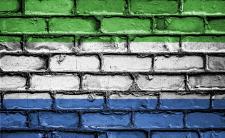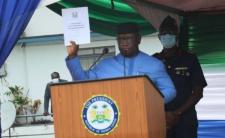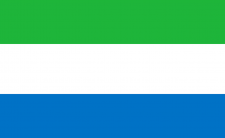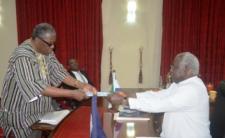Background
Located in West Africa, Sierra Leone has an estimated population of 5,612,685 people. It gained independence from Great Britain in 1961 and opted for a parliamentary system within the British Commonwealth.
The Constitution of 1961
Written as part of the transition to independence, it provided for a Westminster-style parliamentary democracy. The head of State was the British Monarch represented by the Governor General delegated. A prime minster headed the government which was chosen from among Members of Parliament. The government was responsible to the Parliament which could sanction it through censure votes. In practice, however, weak coalition arrangements within parliament limited the institution’s ability to effectively control the executive, as a result of which the latter gained more and more discretionary power.
The Constitutions of 1971 and 1978
In 1967 Siaska Stevens, representing the All People’s Congress (APC) party, won the general elections and became the Prime Minister. In 1971 the parliamentary system was abolished in favor of a presidential system, following the adoption of a new Constitution. Stevens became Sierra Leone’s first executive President. This Constitution lasted until 1978 when a new one was adopted via referendum. The 1978 Constitution replaced the multi-party system with a single party state. The result was the absorption of the Sierra Leone Peoples Party (SLPP), the second political force in the country into Stevens’ All People’s Congress (APC), which became the only recognized political party in the country.
The new Constitution increased executive powers and extended presidential term limits from four to seven years. Additionally, Chapter IV, Section 34 gave him the power to appoint the Electoral Commissioners and the Chief Justice (head of the Judiciary) as well. The Electoral Commission, the organ entitled to accept or reject candidates for the Parliament, was also controlled by him as the Constitution states it is responsible to the President.
In that way, the parliamentarians elected were mainly accountable to the President. This reality made it difficult to control the executive so that in practice the system functioned almost like a one party regime.
The Constitution of 1991
Influenced by events elsewhere such as the fall of the Berlin Wall, pressure from the West to democratize and reform movements in the neighborhood, especially francophone West Africa where one party regimes were disappearing, opposition to one- party rule became stronger in Sierra Leone in the early 1990s. A socially extended coalition demanded a liberalized political system as socio-economic conditions worsened. In this context, President Momoh appointed a 35- member National Constitution Review Commission to recommend constitutional changes that would provide alternatives to the one party state and reform the political system. This resulted in a new constitution that reinstated multi-party politics.
Sierra Leone’s 1991 Constitution recognized separation of powers with provisions for oversight and institutional accountability. It vested the power of judicial review in the Supreme Court. This Constitution was, however, short-lived. Following a military coup led by a young officer, Valentine Strasser, in April 1992, the Constitution was suspended, all political parties banned and powers concentrated in Strasser’s National Provisional Ruling Council (NPRC).
Structure of Government under the 1991 Constitution
Executive branch
The President of the Republic of Sierra Leone is head of state with full executive, as well as commander-in-chief of the Armed Forces. The presidential term is five years renewable twice. The Vice President is the Principal Assistant to the President. Ministers and Deputy Ministers offices may be appointed by the President who determines the general policy of the Government. In the exercise of his functions, the President may act with the advice of the Cabinet.
Legislative branch
The legislative power of Sierra Leone is vested in a unicameral Parliament which is the supreme law making body of the country. It consists of the President, the Speaker and the Members of Parliament. There is one Member of Parliament for each District. The Parliament is composed of 124 members of which 112 are elected by popular vote, while 12 other seats are filled by paramount chiefs elected in different elections. The Members of the Parliament’s term is five years. Parliament can amend the Constitution by a two-thirds majority vote.
Judicial branch
The judiciary is headed by the Chief Justice and comprises the Supreme Court, the Court of Appeal and the High Court. At the apex of the hierarchy of courts in Sierra Leone is the Supreme Court. The Head of the Judiciary is vested in the Chief of Justice, who benefits from the same guarantees as Judges of the Supreme Court of the Judicature.
New Constitutional developments and challenges
In 1991 Sierra Leone was embroiled in a civil war when rebel soldiers from the Revolutionary United Front (RUF) overthrew the one-party political system, demanding a multiparty system. The RUF organized a terror campaign killing approximately 300,000 people in 11 years. The conflict came to an end with the help of Britain and the United Nations peacekeeping mission, following the signing of the Lome Peace Accord in 2002. The Lome Accord called for called for a review of the 1991 Constitution.
Additionally, the Truth and Reconciliation Commission (TRC), established in 2002, also recommended the building of a new constitutional framework to secure peace and consolidate democratic governance. The country is currently in the process of reviewing the 1991 Constitution following the establishment of a constitutional review committee in July 2013. Using as a working document the 2008 report developed and submitted to the government by the Peter Tucker Constitutional Review Commission, the committee consults widely with the public and recommendations to the government, which will then submit it together with proposed changes to parliament for approval. A referendum is expected to endorse the document if parliament approves it. The Committee is made up of 80 members drawn from different sectors. The review process is being carried out in partnership with the United Nations in order to ensure transparency and is expected to last two and a half years.
Structure of Government
| Branch | Hierarchy | Selection | Powers | Removal |
|---|




Share this article